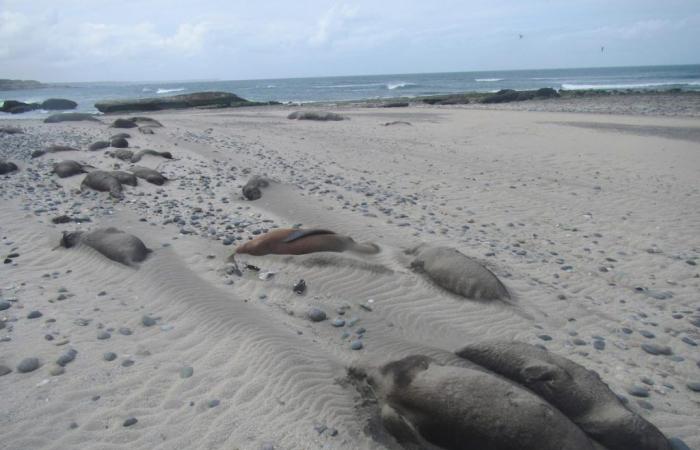A bird flu is killing tens of thousands of seals It is sea lions in different parts of the world, disrupting ecosystems and perplexing scientists, who see no clear way to stop the devastating virus.
The worldwide bird flu outbreak that began in 2020 caused the deaths of millions of domesticated birds and spread to wildlife around the world. This virus is not considered a major threat to humans, but its spread in agricultural operations and wild ecosystems has caused widespread economic turmoil and environmental disruption.
Seals and sea lions as far away as Maine and Chile appear to be especially vulnerable to the disease, scientists said. The virus has been detected in seals on the U.S. East and West Coasts, causing the deaths of more than 300 seals in New England and a few others in Washington’s Puget Sound. The situation is even more dire in South America, where more than 20,000 sea lions have died in Chile and Peru and thousands of elephant seals have died in Argentina.
The bird flu virus can be controlled in domesticated animals, but it can spread unchecked in wildlife, and marine mammals such as South American seals that have had no prior exposure to it have suffered devastating consequences, said Marcela Uhart, director of the Latin America program at the Karen C. Drayer Wildlife Health Center at the University of California, Davis.
“When the virus is in wildlife, it spreads like wildfire as long as there are susceptible animals and species,” Uhart said. “The movement of animals spreads the virus to new areas.”
Scientists are still researching how the seals contracted bird flu, but it is most likely through contact with infected seabirds, Uhart said. High mortality has consistently affected South American marine mammals since the virus arrived in late 2022, and birds in Peru and Chile have died by the hundreds of thousands from the virus since then, she noted.
The virus is still spreading and was first detected on mainland Antarctica in February.
The deaths of seals and sea lions disrupt ecosystems in which marine mammals serve as important predators near the top of the food chain. Seals help keep the ocean in balance, preventing overpopulation of the fish species they feed on.
Many of the affected species, such as South American sea lions and southern elephant seals, have relatively stable populations, but scientists worry that the virus could spread to more endangered animals. Scientists said bird flu may have played a role in the deaths of hundreds of endangered Caspian seals in Russia last year.
“Wildlife loss on the current scale presents an unprecedented risk of wildlife population collapse, creating an ecological crisis,” the World Organization for Animal Health, an intergovernmental organization, said in a statement.
In New England, scientists at Tufts University’s Cummings School of Veterinary Medicine found that an outbreak of bird flu that killed more than 330 gray and harbor seals along the North Atlantic coast in 2022 turned out to be worse than initially thought. It is possible that the seals contracted the seagull virus by coming into contact with droppings from sick seagulls or by feeding on an infected bird, the scientists reported.
The US government determined that the seal extinction was an “unusual mortality event” attributable to bird flu. The National Oceanic and Atmospheric Administration declared the event over, but there are still concerns about a possible repeat.
“Marine mammals are still quite unique in the scale of the outbreaks that are occurring,” said study author Wendy Puryear from Tufts. “One of the connections is that there is a large amount of virus circulating in coastal birds. There are many opportunities for these wild birds to host the virus and transmit it to marine mammals.”
Some scientists and environmental advocates say there may be a link between the outbreaks and climate change and warming oceans. Warmer sea temperatures north of Chile decrease forage fish populations, which makes sea lions weaker and more susceptible to disease, said Liesbeth van der Meer, director of the environmental group Oceana in Chile.
Scientists and environmentalists hope that vaccinating poultry will help slow the spread of the disease, van der Meer said, adding that it is also important for people to avoid potentially infected animals in the wild.
“Authorities have carried out campaigns about the disease, strongly recommending staying away from seabirds or marine mammals showing symptoms or found dead in coastal areas,” van der Meer said.
Not even seals in aquariums are considered completely safe from bird flu. The New England Aquarium, where outdoor seal exhibits delight thousands of visitors every year, has taken strict health precautions to prevent transmitting the virus to its animals, said Melissa Joblon, director of animal health at the Boston Aquarium.
Staff are not allowed to bring backyard poultry products into the aquarium, and an awning protects the seal exhibit from birds that could carry the virus, she said.
“We know it’s a risk to the animals that live here,” Joblon said, adding that none of the aquarium’s seals have been infected.
The deaths of marine mammals are even more worrying due to mutations in the avian virus, according to an article published in the magazine Nature Communications last fall. The mutations “warrant further examination and highlight an urgent need for active local surveillance to manage outbreaks and limit spread to other species, including humans,” the study said.
Another study, published in the magazine Emerging Infectious Diseases in February, it discovered that the bird flu virus has adapted to spread between birds and mammals. Researchers found nearly identical samples of the virus in dead sea lions, a dead seal and a dead seabird. They said the discovery is significant because it confirms a multi-species outbreak that could affect marine mammals and birds.
More seal deaths could disrupt critical ecosystems around the world, said Lynda Doughty, executive director of Marine Mammals of Maine, a marine mammal rescue organization that treated seals with bird flu during the outbreak in New England.
“You need that happy ecosystem. If we are eliminating some important species, what will be the trickle-down effect of that? That’s the million-dollar question,” Doughty said. /AP






